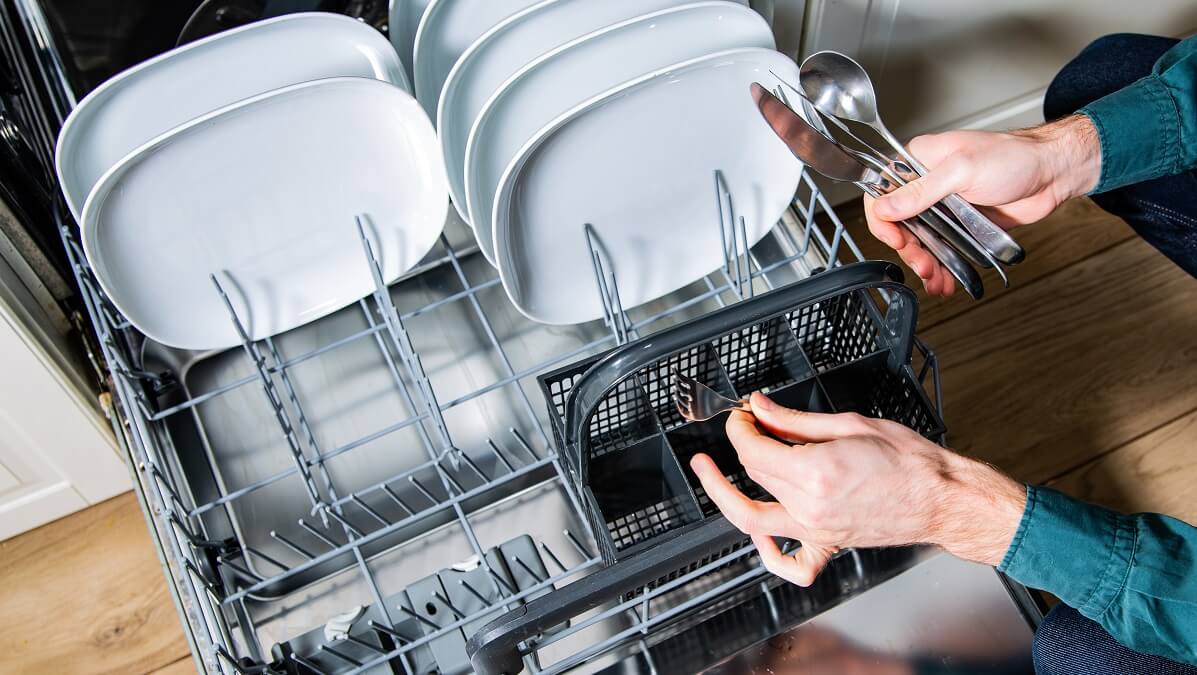The one thing I remember from my food technology class at school is to load knives tip down in the dishwasher. My teacher, unfortunately, found that out the hard way and made sure we would never make the same mistake.
Now it’s second nature to me, but what about forks and spoons?
What do the manuals say?
Well, it seems even dishwasher manufacturers can’t agree on anything but knives.
LG says forks and spoons up but knives down for safety.
Read: How to properly load your dishwasher
The GE appliances website says to place forks and knives handles up, but spoon handles down if there is a large load of silverware in the basket.
Bosch recommends placing unsorted cutlery in the basket with the tips down and with knives and other sharp utensils on the knife shelf.
Fisher & Paykel offers no specific instructions about spoons and forks, so it’s up to the consumer.
An expert’s verdict
CHOICE expert in dishwashers Ashley Iredale says it’s down all the way. Here are his top three reasons why.
Safety
“The last thing you want to do is get your clean knives and forks dirty again by bleeding all over them because you stabbed yourself reaching into the tub without due care and attention,” says Mr Iredale.
“While you’d have to be especially aggressive to do yourself an injury on a spoon, forks can do just as much damage to you as knives if they’re tines up.”
It’s easier to unload
If handles are exposed, they’re easier to grab and put away.
“It goes slightly smoother if everything’s facing the same direction from the outset,” says Mr Iredale. “It’s not a huge deal – you’re saving seconds, not days. But hey, the whole point of a dishwasher is to save time and effort in the kitchen, so every little bit counts.”
Fewer germs and smudges
If the handles are easily available, you’ll avoid touching the ends of the cutlery that touches your food, which has to be a good thing.
“Your fingers are covered in germs and bacteria, so obviously you want to minimise touching any surface that’s going to come into contact with your food if you can,” says Mr Iredale.
“On a more benign level, your fingers could also leave smudges on the shiny blades of knives, which isn’t a good look if you have guests over.”
Some things, such as your best knives, should be kept out of the dishwasher entirely as the blades can be dulled or damaged.
Read: Common kitchen cleaning mistakes and their simple fixes
Does cutlery wash better either way?
Some people are convinced stacking cutlery handle down gives a better clean as the heads are more exposed to the jets of water.
Mr Iredale says that may be true, but the difference will be marginal and definitely not worth the risk of injury.
If you’re often left with a less than stellar clean on your silverware, it might be down to your stacking technique. Here are some things to remember.
Don’t group cutlery together
One thing all the experts and manufacturers can agree on is to not group cutlery of the same type together. If you sort them into categories, they often end up nesting together.
Separating silverware so that forks, knives and spoons are mixed and evenly distributed allows the water to circulate around each utensil, giving a cleaner result.
Keep wooden spoons out of the dishwasher
The detergent will eat away at the wood, while the heat and moisture may cause it to warp and split.
Read: Things you should never put in your dishwasher
Utilise the top shelf
Put your bigger utensils, such as long knives and chopsticks, on the top rack to ensure they don’t stick out and prevent the cleaning arms from spinning.
Ladles should face open side down to avoid water pooling in them, while tongs should be at least partially open to avoid food getting stuck in them.
No mixing
Do not mix sterling silver with stainless in your silverware basket. The stainless can cause pitting of the sterling silver if nested against it.
Location of basket
The silverware basket should always be placed in the lower rack unless the owner’s manual suggests otherwise.
Cutlery basket or tray
Mr Iredale tackled the question of cutlery basket vs tray. “From an expert point of view, it makes no difference. But I’m a basket man,” he said.
“I find loading and unloading each item individually in the tray is a time-consuming chore, and the cutlery tray also reduces the height of other items you can put in the dishwasher.”
How do you stack your dishwasher? Do you have any cutlery you always wash by hand? Share your tips in the comments section below.


The cutlery basket on my Fisher & Paykel dishwasher has a plastic grid that means that everything except knives has to go in handle down.
I always put the knives blade down in one section, and the spoons, forks & teaspoons in the other sections so that when the basket is emptied, you can pick up the knives by the handle & not the blade, so that there’s no issue with cuts, and the rest can be put straight away without having to sort them out.